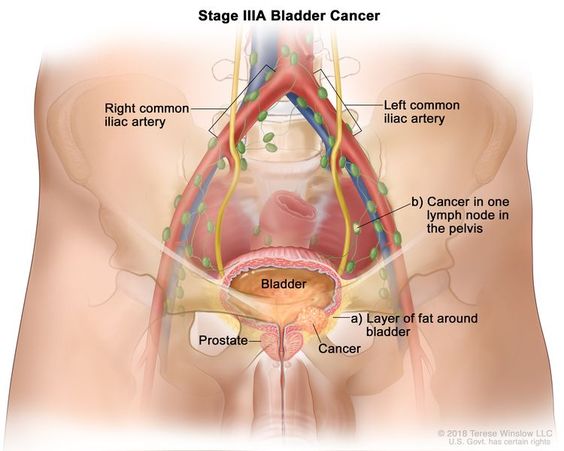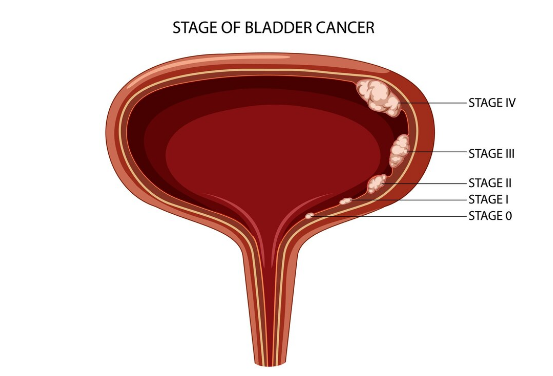Bladder Cancer: Symptoms, Causes & Treatment
Bladder cancer is a relatively uncommon malignancy originating from the epithelial lining of the bladder. Treatment modalities for cancer of the bladder encompass various approaches, among which surgical intervention aimed at removing cancerous tissue is commonly employed.
Despite treatment,bladder tumor has the potential for recurrence, underscoring the importance of vigilant follow-up care with healthcare providers for individuals diagnosed with this condition. Regular monitoring and adherence to recommended surveillance protocols are essential to effectively detect and manage potential recurrences.
What is bladder cancer?
Bladder cancer, a relatively infrequent malignancy originating in the urothelial lining of the bladder, affects the small hollow organ responsible for urine storage. Healthcare providers employ various treatment modalities for bladder tumor, with surgical excision representing a prominent approach. Despite treatment, bladder tumor recurrence is a concern, necessitating diligent follow-up with healthcare providers.
Early-stage cancer of the bladder denoting cancer confined to the bladder mucosa or submucosa and treated before metastasis occurs, is amenable to treatment. However, approximately 75% of early-stage cancer of the bladder recur. Vigilant surveillance and proactive management strategies are imperative to address potential recurrences effectively.
How Does This Condition Affect My Body?
The bladder, a triangular-shaped organ situated centrally between the hip bones, resides anatomically above the urethra and beneath the kidneys. It serves as a urine reservoir, draining from the kidneys into the bladder.

The bladder is lined with specialized tissue known as urothelium, comprising cells that exhibit elasticity, stretching as the bladder fills with urine and contracting when empty. The bladder’s capacity typically accommodates approximately 2 cups of urine.
bladder tumor arises from the abnormal proliferation of certain cells within the urothelial tissue lining the bladder. These mutated cells change, leading to the formation of tumors within the bladder.
If left untreated, bladder tumor can progress, infiltrating through the bladder walls and potentially spreading to nearby lymph nodes and distant sites such as the bones, lungs, or liver. Vigilant management and prompt intervention are essential to mitigate the progression of bladder cancer and prevent metastasis.
What Are Bladder Cancer Types?
There are three types of bladder tumor Each type is named for the cells that line the wall of your bladder where the cancer started. bladder tumor types include:
- Transitional cell carcinoma: The most common type of bladder tumor , transitional cell carcinoma, arises from abnormal transitional cells within the bladder lining. This cancer can spread from the inner lining to deeper layers of the bladder or beyond the bladder wall into surrounding fatty tissues.
- Squamous cell carcinoma of the bladder originates from the thin, flat squamous cells that line the bladder’s interior. This subtype represents approximately 5% of cancer of the bladder cases and often occurs in individuals with a history of chronic bladder inflammation or irritation.
- Adenocarcinoma of the bladder refers to cancers originating from epithelial cells that line various organs, including the bladder. This subtype of bladder tumor is exceedingly rare, comprising approximately 1% to 2% of all cancer of the bladder cases.
- Small cell carcinoma of the bladder is an exceptionally rare form of bladder tumor impacting an estimated 1,000 individuals in the United States.
- Soft tissue sarcomas originating from bladder muscle cells represent a rare occurrence.
Healthcare providers may also classify bladder tumor based on its invasion status, categorizing it as noninvasive, non-muscle-invasive, or muscle-invasive.
- Noninvasive bladder cancer typically involves tumors localized within a confined area of bladder tissue or cancerous growth limited to the surface layer of the bladder lining.
- Non-muscle-invasive bladder tumor denotes the presence of cancer cells that have penetrated deeper into the bladder tissue but har cancer is characterized by the infiltration of cancerous cells into the muscular wall of the bladder, with potential spread into adjacent fatty tissues or surrounding organs.
How common is bladder cancer?
Bladder cancer ranks as the fourth most prevalent cancer among men and individuals designated male at birth (DMAB). Men and DMAB individuals are four times more susceptible to developing bladder tumor compared to women and individuals designated female at birth (DFAB).

However, when bladder tumor does occur in women and DFAB individuals, it often presents in advanced stagels may overlook hematuria, which is the primary and most significant symptom of bladder tumor , as s due to a lack of awareness regarding cancer of the bladder symptoms. Women and DFAB individuathey associate it with common gynecological issues.
Bladder cancer predominantly affects individuals aged 55 and older, with the average age at diagnosis being 73 years. White men and DMAB individuals are twice as likely to develop cancer of the bladder compared to Black men and DMAB individuals.
Symptoms and Causes
What’s usually the first symptom of bladder cancer?
Hematuria, characterized by blood in the urine, is the predominant symptom of bladder cancer. However, it is crucial to acknowledge that hematuria alone does not definitively indicate bladder tumoras other medical conditions can also present this symptom. Nevertheless, individuals should promptly seek medical assessment from a healthcare provider upon noticing blood in their urine. Additional symptoms associated with bladder tumor include:
- Hematuria, or the visible presence of blood in the urine, is a condition where medical professionals may detect minute amounts of blood in urine during a urinalysis.
- Dysuria, or pain during urination, is a burning or stinging feeling that you may experience either before or after you urinate. Penises for men and DMAB may hurt before or after urinating.
- Urging frequently: Urinating frequently in 24 hours indicates that you must urinate frequently.
- Having problems urinating: You may not be able to urinate as strongly as normal, or the flow may come and go.
- Chronic bladder infections: Symptoms of cancer of the bladder and bladder infections are similar. If your antibiotic-treated bladder infection doesn’t improve, contact your healthcare physician.
What causes bladder cancer?
Researchers and medical professionals are unsure of the precise cause of some bladder cell mutations that result in malignant cells. Nmerous risk factors have been identified that may raise your risk of cancer of the bladduer, such as:

- Smoke from cigarettes: The risk of bladder tumor is more than doubled when you smoke cigarettes. Additionally, secondhand smoke exposure and pipe and cigar smoking may raise your risk.
- Radiation exposure: Getting radiation therapy for cancer may make you more susceptible to cancer of the bladder
- Chemotherapy: You may be at higher risk using certain chemotherapy medicines.
- Exposuchemicalsre to specific chemicals: Research indicates that there may be a higher risk for those who work with specific found in paint, rubber, leather, dyes, and some fabrics and hairdressing supplies.
- Frequent bladder infections: Individuals may be more susceptible to squamous cell carcinoma if they frequently experience bladder infections, bladder stones, or other urinary tract infection
Diagnosis and Tests:
How do healthcare providers diagnose bladder cancer?
Medical professionals perform several tests to identify bladder tumor such as:
- Urinalysis: A range of tests are used by providers to examine your urine. To rule out infection in this situation, a urinalysis may be performed.
- Cytology: Medical professionals look for cancerous hints in cells under a microscope.
- The main test used to detect and diagnose bladder tumor is a cystoscopy. During this test, medical professionals observe your bladder and urethra through a lit tube called a cystoscope, which is about the size of a pencil. They might use a fluorescent dye and a unique blue light that enhances the visibility of cancer of the bladder .While doing cystoscopies, healthcare providers may also collect tissue samples.
If urinalysis, cytology and cystoscopy results show you have bladder malignant growth, medical care suppliers then, at that point, do tests to dive more deeply into the disease, including:
- Transurethral resection of bladder tumors (TURBT): This treatment is used by providers to remove bladder tumors so that further testing can be performed. As a therapy option, TURBT operations can eliminate bladder tumors before they have a chance to infiltrate the muscle wall of your bladder. Anesthesia, either spinal or general, is used for this outpatient test.
- A computer, radio waves, and a magnet are used in the magnetic resonance imaging (MRI) test to create finely detailed images of your bladder.
- Computed tomography (CT) scan: This test is used by providers to determine whether cancer has progressed from the bladder.
- A chest X-ray allows medical professionals to look for evidence that cancer of the bladder has migrated to the lungs.
- Bone scan: Similar to an X-ray of the chest, a bone scan looks for evidence that cancer of the bladder has progressed to the bones.
Next, medical professionals stage the illness based on their knowledge of the cancer. Cancer staging aids in planning care and developing a possible prognosis or predicted result for the patient.
Both early-stage and invasive bladder tumor are possible; the former only affects the bladder’s lining, while the latter penetrates the bladder wall and may spread to lymph nodes or adjacent organs.
The phases go from IV (invasive) to TA (limited to your bladder’s interior lining). The cancer has not yet spread to the bladder’s primary muscle wall during its early stages (TA, T1, or CIS). Instead, it is limited to the bladder’s lining of the connective tissue directly beneath it.
Management and Treatment
How do medical professionals treat bladder cancer?
There are four kinds of bladder malignant growth treatment. These treatments can be used separately or in combination by providers.
Surgery:
Surgery stands as a primary treatment modality for bladder tumor , with the choice of surgical approach dependent on the cancer’s stage. Transurethral resection of bladder tumor (TURBT), commonly utilized for both diagnosis and treatment, is often effective for noninvasive bladder tumor that has not metastasized.

During TURBT, healthcare providers either excise the tumor or perform fulguration, utilizing high-energy electricity to ablate it.
Radical cystectomy represents another treatment option, particularly for advanced bladder tumor cases. This extensive surgical procedure involves the removal of the bladder along with adjacent organs. In individuals designated male at birth (DMAB), the procedure may entail removal of the prostate and seminal vesicles.
In contrast, in individuals designated female at birth (DFAB), it may involve removal of the ovaries, uterus, and partial vagina. Urinary diversion surgery may also be performed to facilitate urination post-bladder removal.
Following surgery, healthcare providers may recommend adjuvant therapy, such as chemotherapy or radiation therapy, to eradicate any residual cancer cells and minimize the risk of recurrence.
Warning Signs of Bladder Cancer:
The primary warning sign of bladder tumor is blood in the urine (hematuria). Any instance of hematuria should prompt immediate consultation with a healthcare provider.
Prevention of Bladder Cancer:
While prevention of bladder tumor may not always be feasible, understanding potential risk factors associated with its development can be beneficial. Factors that may increase the risk of bladder tumor include:
- Cigarette smoking significantly elevates the risk.
- Exposure to radiation therapy or certain chemotherapy drugs.
- Occupational exposure to chemicals such as aromatic amines.
- History of frequent bladder infections, bladder stones, or other urinary tract diseases.
- Previous occurrence of cancer of the bladder predisposes individuals to recurrence.
Prognosis:
Left untreated, cancer of the bladder can metastasize and impact life expectancy. However, early detection and treatment significantly enhance survival rates. According to the National Cancer Institute, the five-year survival rate for individuals with early-stage bladder tumor who receive treatment is 96%. Overall, 77% of individuals diagnosed with cancer of the bladder survive for at least five years post-diagnosis.
Living With Bladder Cancer:
Approximately half of bladder tumor cases are diagnosed at an early stage, facilitating relatively straightforward treatment. However, regular follow-up care is essential post-treatment due to its propensity for recurrence. Adopting a heart-healthy diet, focusing on high-fiber foods, engaging in gentle exercise, and connecting with support networks can aid in self-care.
Urinary Diversion:
In cases necessitating bladder removal surgery, known as cystectomy, urinary diversion procedures may be performed to redirect urine flow. These surgeries involve converting a portion of the intestine to create a passageway or reservoir for urine storage. It’s crucial for individuals facing urinary diversion surgery to understand the potential lifestyle adjustments and to discuss the benefits and drawbacks of each surgical approach with their healthcare provider.
When to Consult a Healthcare Provider:
Individuals who have undergone cancer of the bladder treatment should promptly notify their healthcare provider of any symptoms suggestive of cancer recurrence.
What questions should I ask my doctor?
For individuals seeking further understanding of bladder tumor and its management, the following questions may be helpful:
- What is the stage of my bladder tumor?
- What treatment options are available?
- What are the potential side effects of treatment?
- Will I require surgery?
- How will surgery impact my daily activities?
- How frequently doesbladder tumor recur?
- How is recurrent bladder tumor treated?
- Are there any clinical trials available?
- What are the risk factors for recurrent bladder tumor?
IN SUMMARY:
Bladder cancer is a significant health concern, with its most common warning sign being the presence of blood in the urine. While prevention strategies are limited, understanding risk factors associated with the disease can aid in early detection and treatment.
Surgical interventions, including transurethral resection and radical cystectomy, are common approaches, often complemented by chemotherapy or radiation therapy.
Regular follow-up care is crucial post-treatment due to the potential for recurrence. Urinary diversion surgeries may be necessary in cases of bladder removal, necessitating careful consideration of lifestyle adjustments.
Consultation with healthcare providers and proactive self-care measures, such as maintaining a heart-healthy diet and engaging in regular exercise, can contribute to optimal management of bladder tumor


